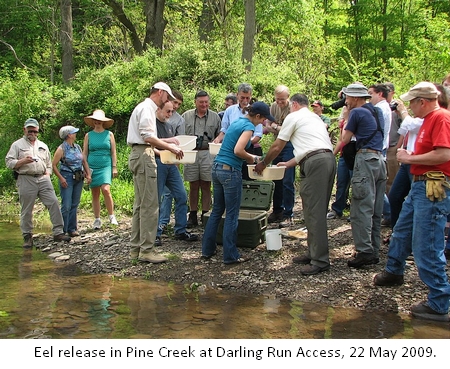Unfortunately, dams on the lower Susquehanna have prevented the eels from migrating upstream, and this, in turn, has kept the mussels from breeding. As a result there are very few mussels left in the upper Susquehanna watershed, and the ones left of this beneficial species are very old. The release of eels into the watershed is an attempt to encourage freshwater mussel reproduction and restore balance to the Susquehanna Watershed ecosystem. However, American eels have very complex migration patterns, and much research needs to be done on them as they are reintroduced. In order to do this, PA Audubon and TogetherGreen (a National Audubon Society program funded by Toyota) provided funding for the project through the Tiadaghton Audubon Society.
Some of the first eels to be released were collected in Susquehanna River tributaries below the Conowingo dam. These were brought back to the USGS Northern Appalachian Laboratory in Wellsboro where they were measured, weighed, and tagged before being released into Pine Creek.
Very small electronic tags were used at first, but this did not work out very well. Electronic tracking was not practical because of the depth and width of Pine Creek, and electroshocking to find the eels already released did not work either, perhaps because the sampling was too small and because no one knew where exactly to look for them after they were released.
Subsequently tens of thousands of small "glass" eels (most under six inches) were released into Pine "Creek and into Buffalo Creek. Recent stream surveys showed this effort to be successful. The eels have grown rapidly in the food-rich waters, and many have been found to be infected with mussel larvae. Hopefully, new beds of young mussels will soon appear, all contributing to improving water quality in the Susquehanna watershed.







No comments:
Post a Comment
Note: Only a member of this blog may post a comment.